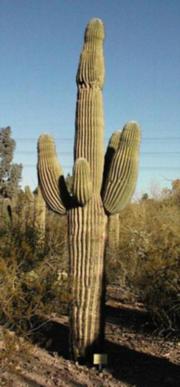

Genus: Carnegiea
Species: gigantea

The Saguaro Cactus has a smooth and waxy skin and is covered with two-inch spines that are located on the tree's vertical ribs. In May and June, the Cactus bears creamy white flowers with yellow centers that measured about three inches. The Saguaro Cactus flower can be found on the end of the branches. The flower only opens on cooler nights and is closed during the heat of midday. The stem of the cactus can be 18 to 24 inches in diameter, The Cactus and its branches grow upright as do all cacti in the southwestern U.S. When it rains the Saguaro Cactus soaks up water and holds it in its ribs. Since it does not rain a lot in the desert, the cactus uses the water that it stores when it doesn't rain. The Saguaro Cactus is Arizona's state flower. The average lifespan for a Saguaro cactus is about 200 years.
The Saguaro Cactus lives in an especially rocky terrain consisting of desert slopes and flats. The Saguaro cactus also lives in bajadas or lowlands. The cactus likes a hot, dry climate. It does not need a lot of water to survive. The Saguaro Cactus lives only within the Sonoran Desert of southeastern California, southern Arizona, and northwestern Mexico. In the Sonoran Desert, the Saguaro Cactus can grow in very limited areas below elevations of 3,500 feet.
The Saguaro Cactus can absorb a lot of water because the ribs on the plant can expand. The Saguaro Cactus has an amazing root system. The root system is very shallow for such a tall, heavy plant. The Saguaro Cactus has one tap root that is only about three feet long. It also has two sets of radial roots. One is a thick root system, which is only about one foot long, and there is also a thinner root system that grows to a length equal to the height of the Saguaro Cactus.
The Saguaro Cactus has a very strong framework consisting of three different structural features. There is a woody tissue that runs parallel up and down the Saguaro to form a cylindrical shape. There is also a thick whitish pith, and a fleshy tissue. Downward pointing spines make it easier to direct rainwater into the depressions of the cactus. The spines help to cool the outer skin. The spines also help redirect the wind and insulate the plant. Many animals eat the Saguaro Cactus; the Long-Nosed bat, bees, wasps, ants, and butterflies drink the nectar of the Cactus flower. Small animals such as the Pack Rat, and Pocket Mice will come to eat the Cactus. Gila woodpeckers like the interior of the Saguaro Cactus because it is the only plant it can hollow out for their nest in the desert. The woodpecker will drill 2 to 3 holes before it decides to live in one. It will peck right into the soft tissue that is used to store water. The cactus will fix the damage by sealing up the inside with "callous scar tissue" and that stops water loss. The Saguaro Cactus is protected by the United States government, because the Saguaro Cactus was beginning to disappear from the landscape. There is a national park to protect the Saguaro Cactus. The name of the park is Saguaro National Park.
by Alice H. 2001
biliography:
Linda Macmillan Ply, "Saguaro Cactus: Grand Symbol of the West (DesertUSA)", http://www.desertusa.com (October 2000)
"Saguaro Cactus", http://www. desertusa.com/july96/du_saguaro.html (October 2000)
Gross, Alexandria "San Francisco State University", http://dss.sfsu.edu/geog/bholzman/courses/fall99projects/saguaro.htm (December 2000)